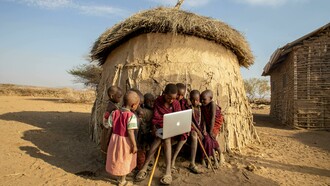We don't have any food shortages in our villages, despite the lockdown.
(Dalit women farmers, Telangana)
We saved up enough in our village fund over the last few years, by sustainable harvest of forest produce, to provide for people who have lost their jobs in cities and returned home during the corona crisis.
(Kukdel Village, Maharashtra)
We can produce our own masks and sanitizers, why buy from companies?
(Women of Kudumbashree, Kerala)
Impact of the state’s response to COVID
The above narratives from so-called ‘ordinary’ people in so-called ‘backward’ villages of India, are in stark contrast to the much more visible and widespread stories of distress caused by the economic and social fall-out of COVID-19. Across the country, a stringent lockdown was suddenly imposed by the Indian government on 24th March, and extended twice till 17th May with only a few relaxations. Whether or not this was necessary to contain the virus has been debated, but one thing is clear: the utter lack of preparedness, and indeed the callous disregard of the state to deal with the consequences, has had horrific consequences for hundreds of millions of people. With the lockdown, several million migrant labourers working in construction, industries, and so on, were left stranded, with no work, and unable to get back home. Many million street vendors, small-scale businesspersons and traders, dependent on daily earnings, had no income for weeks. Millions of primary sector producers (including craftspersons) were unable to get their produce to markets, and perishable commodities, well, perished. People already on the social margins, like transgender persons and sex workers, have been further marginalized.
These consequences have also exposed the serious faultlines in Indian society (as it has for humanity as a whole). For instance, with an economy dominated by poorly conceived or implemented labour policies and increasingly by state-supported capitalism, over 90% of India’s workforce is unorganized or informal, which means that barring those who are relatively self-sufficient in farming, forestry, fisheries, pastoralism, the rest are exposed to highly precarious livelihood conditions. And an increasingly capitalist state that is more and more callous towards the poor, unwilling to accept this mass reality, or lacking the imagination and wherewithal to deal with it. In hundreds of places, civil society organisations, community groups, and individuals have had to step in to generate resources and provide relief. Some states like Kerala and Rajasthan did relatively better than others, but in general, the suffering across India is unprecedented.
Other faultlines exposed are India’s chronic casteism and gender inequality, and an increasing religious divide encouraged by its right-wing hyper-nationalist ruling party. Those already marginalized have faced the worst consequences. And there is the ecological bankruptcy of India’s ‘growth-at-any-cost’ development approach, which has led to massive devastation of ecosystems and wildlife populations, the world’s highest levels of pollution, and decline in nutritional intake from wild foods and traditional crops amongst a vast section of the population. Communities whose ecological resource base has been damaged, are much worse off in the COVID times than those environment is relatively intact, as shown by some examples below.
Pathways out of the crisis
The Dalit women farmers quoted above are part of the Deccan Development Society, a civil society group that has facilitated the establishment of sanghas, women’s committees in about 75 villages in Telangana state. Through these, women who were on the margins of society because of their caste identity (Dalits are the most oppressed section of Hindu society), gender inequity, and small landholding status, have created an agricultural revolution in the last 3 decades. Reviving their dryland, biodiverse agriculture with a heavy focus on nutritious millets, they increased overall production while retaining control over land, seeds, water, and knowledge to achieve food sovereignty, and wiped out hunger in thousands of families. They also started their own media centre, setting up India’s first community-run radio station and a film-making studio. In a project called ConFarm, they have an annual relationship with about 100 families in Hyderabad city, who invest in their farms upfront, receive organic and diverse food in return, and have the opportunity to visit them and work on the farms.
As COVID hit, the DDS women safeguarded themselves and their communities; there is as yet not a single case of infection in these villages. And remarkably, they are contributing 10 kg food grains per family to the district relief measures and feeding 1000 glasses of nutritious millet porridge to health, municipality and police workers in nearby Zaheerabad town.
The second quote above is of one of 90 villages in the Adivasi (indigenous) dominated belt of Gadchiroli in Maharashtra state. These have come together as a Mahagram Sabha (a federation of village assemblies), to fight against state and corporate proposals to do mining in their area, and to establish elements of self-rule. They have also obtained community rights of governance, management and use of their forests, under India’s Forest Rights Act. Reversing a couple of centuries of centralized state control of forests, in which outside contractors would get most of the profits from using forest produce, they now do the harvesting and sale themselves. A substantial part of the proceeds goes into village development funds. It is precisely these funds that Kukdel and several other villages have been able to use in the COVID lockdown situation for their landless families and for their residents who had gone out for labour and had to return jobless. Though they were without the individual economic security to fall back on, the community spirit has ensured that they at least have collective security to tide them over.
Empowerment of local economy is also the fulcrum of the women’s assertion in the third quote above. Kudumbashree is an innovative programme supported by the Kerala state government, running since the late 1990s, enabling dignified livelihoods for tens of thousands of women in their own villages and urban neighbourhoods. Units of the programme in each village facilitate greater interface between residents and government programmes, as also create capacity for local self-governance. A variety of products have resulted, including household items, agro-processing, and handicrafts. With the onset of the COVID crisis, Kudumbashree is working with rural and urban self-governance units to spread awareness of safety measures, and set up community kitchens to cater to those under home quarantine or otherwise needing food aid. As of late April its units have made and distributed over 2 million cotton masks, 5000 litres of sanitizers, and face shields for medical staff across the state. It has of course helped that the state government has been one of the most pro-active in dealing with COVID related crises.
Beyond these three examples, India has hundreds of other initiatives of local self-reliance or self-sufficiency in food, livelihoods, water, energy, sanitation, housing, and other basic needs, or in the creation of just opportunities for marginalized sections of society. Outside Chennai, the village of Kuthambakkam was facilitated by its former sarpanch (village head) Elango Rangaswamy, a Dalit, to generate jobs for 150-200 families through small-scale manufacture. During COVID, Elango has devised a solar-powered disinfectant unit, which he says can be set up easily in any community; earlier he helped the village produce small solar kits for fans and lighting. The nationally active group Goonj, currently reaching relief to over 40,000 families, aims to also use its widespread experience in its Vaapsi restoring livelihoods programme, to create or re-establish localized barter and exchange systems that enable dignified livelihood generation.
In the western India region of Kachchh, entrepreneurial leadership and technological innovation have helped revive handloom weaving to the extent that youth who had gone off to work in factories are coming back. They say that it is not just about the income, but also about being able to work at home, be with the family, express their creativity, be their own boss, and continue their ancestral heritage. In fact Kachchh as a whole is very instructive in how to deal with crises. Aided by committed civil society organisations and to some extent the local government, its communities bounced back through the generation of livelihoods (especially craft-based), decentralized water harvesting, dignified housing, and much else, after a 4-year spell of cyclones, drought, and earthquake had devastated them in 1998-2001.
All the above examples, and many more, have enormous lessons on pathways out of COVID, especially towards empowering communities to be more resilient in the face of any such future crisis. Foremost amongst these is that instead of economic globalization that has left hundreds of millions of people across the world struggling in the wake of the COVID pandemic, localization is the way to go. There are no reason clusters of settlements cannot be self-reliant in most or all basic needs, significantly reducing the need for trade and travel across wider regions. Equally important is radical democracy, where collectives in face-to-face conditions are able to take decisions on matters affecting their lives, while also making elected politicians and bureaucrats accountable (or perhaps even redundant!). Then there is the struggle for justice and equity, removing sexism, casteism, racism, and other forms of inequality and discrimination. In these alternative initiatives there is also the use of multiple knowledge systems, the respect of cultural diversity, and the attempt to connect or reconnect within nature while respecting all of life.
The above set of principles and more has been the message of many a wise person, from Mohandas Gandhi to EF Schumacher to Ivan Illich; it is the central tenet of indigenous worldviews like sumac kawsay and buen vivir and ubuntu and swaraj, and of more recently emerging approaches like ecofeminism and degrowth. There is a pluriverse of alternatives around the world, with India being a microcosm of them.
While at least some civil society groups and state governments are listening, the dominant system in India (as elsewhere around the world), is still dreaming of going back to the pre-COVID ‘normal’, or worse, licking its lips seeing in this crisis an opportunity to consolidate its power and profits. It will take a massive and bold effort on part of progressive forces, to communicate the possibilities of a different direction, and create the social momentum for it.
COVID is more than a tight slap for humanity, it is an opportunity for us to radically change course away from the injustice and unsustainability that underlie our current global crises. And we have plenty of ‘ordinary’ people doing extraordinary things, to light the way, if only we will listen.
(I would like to acknowledge the inputs of people from the above initiatives, and colleagues in Kalpavriksh and the Vikalp Sangam process).















